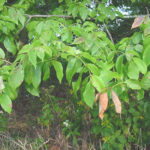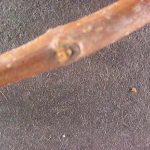white ash (Fraxinus americana)
Family: Oleaceae
Categories |
Images |
|---|---|
| Form:
This is a large tree reaching 70 to 80 ft. in height and 2 to 3 ft. in dbh. It also has a narrow crown. |
|
|
Leaves: Shape: oval to oblong-lanceolate Margin: entire or serrate Texture: glabrous Variation: parallel |
|
| Bark:
The bark has a gray color and is deeply furrowed with narrow interlacing ridges that form a diamond pattern. |
|
| Twigs and Buds:
The twigs are stout, covered with lenticels and are pubescent or glabrous. Lateral buds appear below the top edge of the leaf scar. |
|
| Flowers and Fruit:
Flowers are dioecious and appear before the leaves. The fruit is a samara, that is oval to lanceolate in shape. |
|
| Distinguishing Characteristics:
This species has a pinnately compound leaf, a twig with lenticels and leaf scars that are horseshoe shaped. |
|
| Range:
This species occurs from Maine to eastern Minnesota south to Texas and east to Florida. |
|
| Silvics:
This species has intermediate tolerance and occurs on moist uplands and coves. |
|
| Ecological and Cultural Importance:
The wood of this tree is used for almost all baseball bats and tool handles. Canoe paddles and snowshoes were also made from this species because of its strength. The fruit is eaten by wood ducks, finches, squirrels and mice. |

